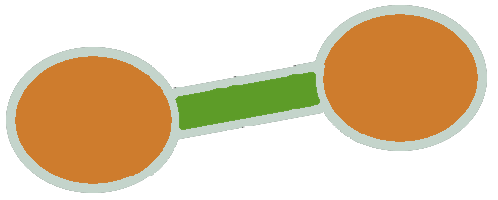Ninatoka
 concept
conceptNeu5gc (n-glycolylneuraminic acid)
N-Glycolylneuraminic acid (Neu5Gc) is a sialic acid molecule found in most non-human mammals. Humans cannot synthesize Neu5Gc because the human gene CMAH is irreversibly mutated, though it is found in other apes.[1] It is absent in human tissues because of inactivation of gene encoding CMP-N-acetylneuraminic acid hydroxylase.[2] The gene CMAH encodes for CMP-N-acetylneuraminic acid hydroxylase, which is the enzyme responsible for CMP-Neu5Gc from CMP-N-acetylneuraminic (CMP-Neu5Ac) acid.[3] This loss of CMAH is estimated to have occurred 2-3 million years ago, just before the emergence of the genus Homo.[4] Neu5Gc is closely related to the commonly known N-acetylneuraminic acid (Neu5Ac). Neu5Ac differs by a single oxygen atom that is added by the CMAH enzyme in the cytosol of a cell. In many mammals, both of these molecules are transferred into the Golgi apparatus so that they may be added to many glycoconjugates. However, in humans, Neu5Gc is not present.[4][5] Neu5Gc is found in most mammals, with exceptions like humans, ferrets, the platypus, western dog breeds and New World monkeys.[6] Trace amounts can be found in humans, even though the gene to encode for production of Neu5Gc was eliminated long ago. These trace amounts come from consumption of animals in human diet. Mainly, the sources are red meats such as lamb, pork, and beef. It can also be found in dairy products, but to a lesser extent. Some 1.1% of the identified Neu5Ac is actually Neu5Gc in commercial whey protein.[7] Neu5Gc cannot be found in poultry and is found in only trace amounts in fish. This confirms that Neu5Gc is mainly found in foods of mammalian origin.[4] Lanolin in shampoo also contains Neu5Gc.[8] In 2017, scientists succeeded in indirectly identifying the presence of Neu5GC from multiple ancient animal fossils dated to over a million years ago, the oldest of which was dated to around 4 Mya.[9] Even though Neu5Gc is not known to be produced by any mechanism in the human body (due to lack of genes), our bodies do interact with trillions of microorganisms that are capable of complex biological reactions. Neu5Gc is reported to be found in concentration in human cancers, as well as in fecal samples, suggesting that humans ingest Neu5Gc as part of their diets. Uptake is thought to be by macropinocytosis, and the sialic acid can be transferred to the cytosol by a sialin transporter. It is possible that the immune system then recognizes the molecule as foreign, and that the binding of anti-Neu5Gc antibodies may then cause chronic inflammation. This assumption has yet to be concretely proven, however.[4] Further studies have shown that humans have Neu5Gc-specific antibodies, often at high levels.[3] Feeding Neu5Gc knockout mice Neu5Gc-rich diets along with anti-Neu5Gc antibodies (attempting to mimic a human system) causes systemic inflammation in the mice, and they are five times as likely to develop hepatocarcinomas.[10][11] However, a study released in September 2018 found no evidence that exposure to higher levels of anti-Neu5gc antibodies increased colon cancer risk.[12] The increased values of anti-Neu5Gc antibodies in patients with hypothyroidism/Hashimoto's disease raise the possibility of an association between anti-Neu5Gc antibody development and autoimmune hypothyroidism.[13] Source: Wikipedia
Ref: The contributor did not provide a reference
Join Ninatoka!!
NinatoKa's goal is to support you as a therapist in unravelling the illness pathway from symptoms to cause, and to help you detect potential interventions.
Go to Explore to start your discovery!
Go to Learn to scroll through newly added data.
Go to Contribute to contribute to the Ninatoka database.
You can rate content up or down and add comments if you agree or disagree.



